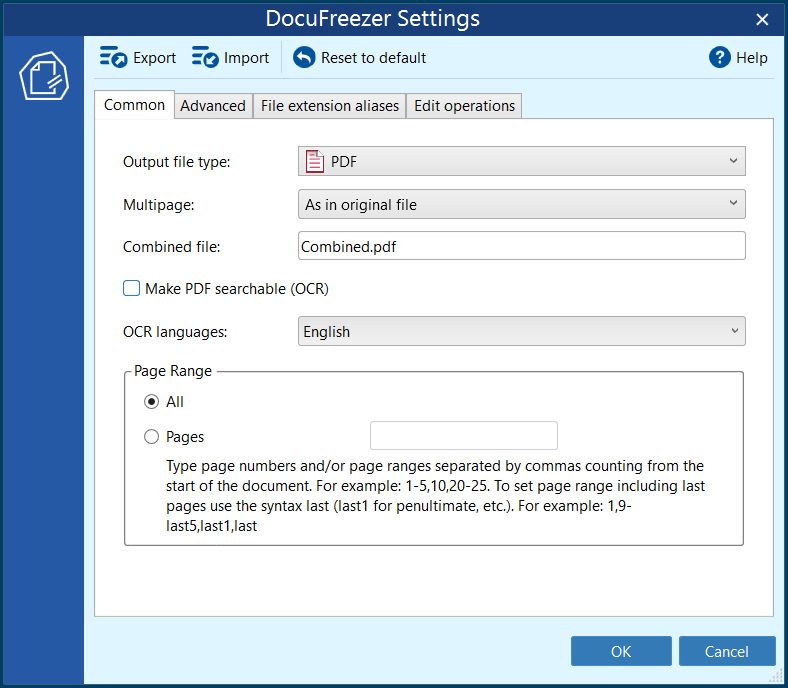To open this settings window, click the Settings button on the top menu and switch to the Common tab. Depending on the Output file type selected, these settings will vary.

On this page
Set Page range
No matter which output file type you choose, you can set Page range. Choose to process all pages or a specific page range by typing in the desired page numbers and/or ranges separated by commas. For example: 1,3,5-10,25. To select pages from the end of the document, use the syntax last (last1 for penultimate page, etc.). For example: 1,5,last2,last1,last
Extract pages from multipage documents
By using the Page range setting, you can extract specific pages from multi-page documents and save them separately or as multi-page files. For instance, you can set Pages: 1 to save only the first page of each processed document, while all other pages will be omitted.
Output file type
Select output file format to convert your files to: JPEG, PDF, BMP, PNG, TEXT, TIFF.
| Setting | Description |
|---|---|
| Multipage |
Set multipage option which will control the structure of output files:
|
| Combined file | Set filename of the multipage output file when Multipage: Merge into one PDF option is used. Default name: "Combined.pdf" |
| Make PDF searchable (OCR) | Recognize text from images or image-based files. This feature allows extracting text into searchable PDF or plain TXT file(s) via a built-in OCR module. |
| OCR languages | With the previous feature enabled, you can select one or more languages that are in your source files. Various OCR languages are available. Try to choose as few languages as possible at once in order to improve OCR accuracy. |
With DocuFreezer, you can also compress PDF by minimizing its size or turn text characters into curves. To learn how to do it, check out more PDF-related settings:
Advanced settings related to PDF (as output format) →
JPEG
| Setting | Description |
|---|---|
| Color space |
Set color space (color mode) for output JPEG images. You can select between:
|
| Quality | Set JPEG quality. You can adjust the quality within a range of 25-100%. Default value: 85% |
Advanced settings related to JPEG (as output format) →
BMP
| Setting | Description |
|---|---|
| Color space |
Set color space (color mode) for output BMP images. You can select between:
|
Advanced settings related to BMP (as output format) →
PNG
| Setting | Description |
|---|---|
| Color space |
Set color space (color mode) for output PNG files. You can select between:
The difference between RGB and RGBA is opacity (transparency). RGB stands for a 3-channel format containing data for Red, Green, and Blue whereas RGBA is a 4-channel format containing data for Red, Green, Blue, and Alpha. Alpha channel allows saving transparency. The difference between Grayscale and Monochrome is that grayscale mode preserves different shades of gray, and monochrome preserves only black & white colors.See illustration |
Advanced settings related to PNG (as output format) →
TEXT
| Setting | Description |
|---|---|
| OCR (Optical Character Recognition) | Enable this feature to batch convert scanned documents or images to plain text (TXT) via OCR |
| OCR languages | With the previous feature enabled, you can select one or more OCR languages. Note: the fewer languages are selected, the more accurate OCRing will be. |
Advanced settings related to TXT (as output format) →
TIFF
| Setting | Description |
|---|---|
| Color space |
Set color space (color mode) for output PNG files. You can select between:
The difference between RGB and RGBA is opacity (transparency). RGB stands for a 3-channel format containing data for Red, Green, and Blue. RGBA is a 4-channel format containing data for Red, Green, Blue, and Alpha. Alpha channel allows saving transparency. The difference between Grayscale and Monochrome is that grayscale mode preserves different shades of gray, and monochrome preserves only black & white colors.See illustration |
| Compression |
Set level of TIFF compression algorithm to reduce output file size. You can manually select between:
|
| Multipage |
Set multipage option which will control the structure of output files:
|
| Combined file | Set filename of the multipage output file when Multipage: Merge into one TIFF option is used. Default name: "Combined.tif" |